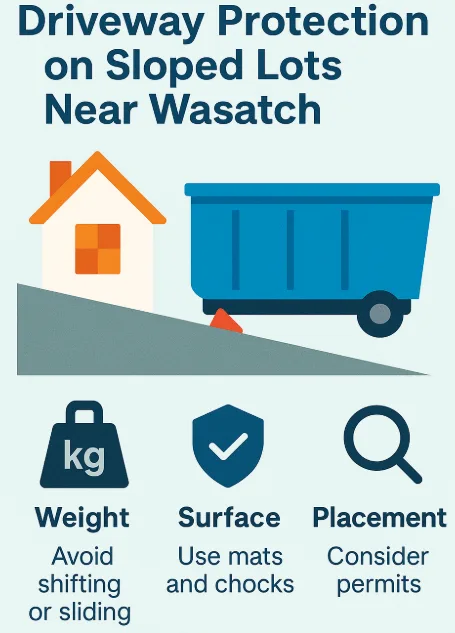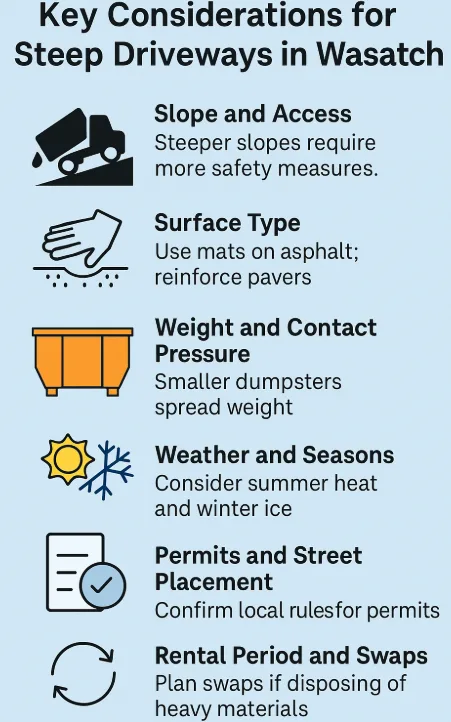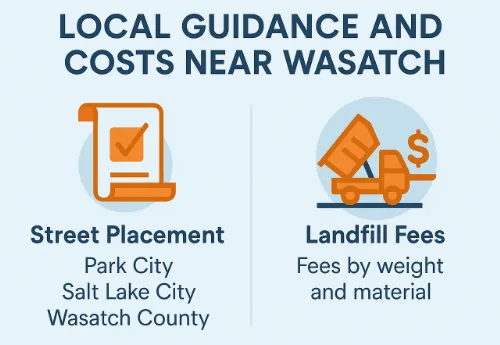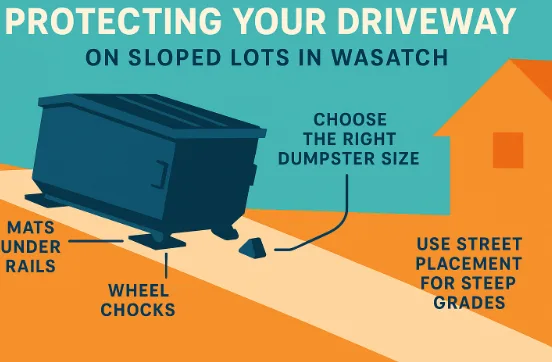Driveway Protection on Sloped Lots Near Wasatch
Homes near the Wasatch often sit on steep driveways. Heavy roll-off dumpsters can slide or shift if not set correctly. Concrete and asphalt surfaces also react differently to heat, cold, and weight. Protecting your driveway means planning for weight distribution, surface protection, and placement. A good setup prevents cracks in new concrete, ruts in soft asphalt, and unsafe conditions during loading or unloading.

How Dumpster Weight and Slope Work Together
A slope adds extra force to the weight of a dumpster. A 20-yard bin filled with roofing debris may hold several tons, which pushes down through its rails. On a steep incline, that weight can also slide. Mats under rails and wheel chocks at the tires keep the container steady. Industry studies show that spreading contact pressure with pads lowers damage to driveways. If you are dealing with fresh concrete, wait until it reaches strength at 28 days or place the dumpster in the street with a permit.
Key Considerations for Steep Driveways in Wasatch
Slope and Access
City and county codes often limit maximum driveway grades. Steeper slopes require more safety measures. Always set brakes and use wheel chocks when loading or unloading. On sharp inclines, use multiple chocks on both sides of the tires.
Surface Type
Concrete is strong but vulnerable during its first winter. Avoid deicing salts on new slabs and always spread loads with mats. Asphalt softens in summer heat, so plywood or composite mats are necessary under rails. Pavers or gravel need a reinforced base such as a plywood runway or interlocking mats.
Weight and Contact Pressure
The size of the dumpster matters as much as the surface it sits on. A 20-yard typically holds 6 to 8 pickup loads. If filled with shingles or concrete, that weight adds up quickly. To protect your surface, smaller dumpsters with swaps may be better than one oversized bin.
Weather and Seasons
Summer heat makes asphalt prone to dents. Winter freeze can cause brittle edges in concrete. Plan delivery in cooler parts of the day during summer and use sand for traction in winter instead of chemical deicers.
Permits and Street Placement
On steep or narrow lots, the safest option is often street placement. Local cities like Park City and Salt Lake City require temporary right-of-way permits. Wasatch County lists driveway and encroachment permits on its site. Always confirm before delivery to avoid fines.
Rental Period and Swaps
Shorter rentals reduce risk. If your project involves heavy materials, plan for a mid-project swap instead of one long load. This keeps the driveway safe and spreads weight across multiple containers.

Dumpster Size Guide for Wasatch Driveways
Dumpster dimensions and capacity vary by hauler, but here are typical sizes and what they mean for driveways on slopes.
Size of Bin: | Ideal Use: | Capacity: |
10-Yard | Small cleanouts or heavy material like concrete and brick where lower weight protects the surface | 4-5 pickup loads |
20-Yard | Roofing jobs, moderate remolds, and yard cleanups | 6-8 pickups loads |
30-Yard | Large cleanouts with bulky but lighter debris | 9-12 pickup loads |
40-Yard | Oversized cleanups with light materials such as furniture or siding | 12-16 pickup loads |
Local Guidance and Costs Near Wasatch
Street placement requires a permit. Park City has right-of-way permit rules, Salt Lake City offers a public-way portal, and Wasatch County lists driveway and encroachment requirements. Landfill tipping fees drive local dumpster pricing. Fees are based on weight and material type, with per-ton charges posted online. Your hauler will also include base delivery, days on site, swap fees, and over-tonnage costs if you exceed the included weight. Always check updated fees before you book.

Common Problems on Sloped Driveways
- Skipping wheel chocks on steep grades, which risks rolling or sliding during loading.
- Placing a 30 or 40-yard bin on hot asphalt without mats, which can cause ruts.
- Setting dumpsters on new concrete before the slab reaches strength, leading to cracks or scaling.
- Forgetting to apply for a street permit, which can lead to tickets and removal.
Checklist for Delivery Day
- Lay plywood or composite mats under rails and wheels
- Add extra mats as a runway for truck tires
- Place wheel chocks on the downhill side and add a second set on strong slopes
- Keep bins away from edges, drains, and corners
- Use sand for traction in winter, not deicers
- Cap loads below the rim and plan swaps for heavy debris
- Move to the street with a permit if the slope or surface seems unsafe
Surface Protection Tips by Driveway Type
Concrete Driveways
Wait at least 28 days after pouring before placing heavy loads. Use mats to spread pressure. Skip deckers in the first winter to prevent damage.
Asphalt Driveways
Use plywood or mats under the rails, especially in summer. Limit how long the dumpster stays in place. Set delivery early or late in the day when temperatures are lower.
Pavers or Gravel Driveways
Add a compacted base with mats or plywood. Avoid placing bins near curbs or edges. A smaller size with more frequent swaps is often safer for these surfaces.
What Shapes Dumpster Pricing Near Wasatch
Prices depend on several parts: delivery, time on site, included tons, overage fees, and permits. Local landfill tipping fees also play a major role. Salt Lake County posts per-ton rates for mixed loads and clean loads like broken concrete. Wasatch Integrated lists per-ton updates with small-load minimums. These fees change often, so confirm them before booking.
.
FAQs About Driveway Protection on Sloped Lots
How should I protect a new concrete driveway if I need a dumpster delivered?
Fresh concrete is especially vulnerable to cracking and surface damage. It takes at least 28 days for concrete to cure to full strength, so dumpsters should not be placed on brand-new slabs before that time. Once the surface is ready, always use driveway protection, composite mats or thick plywood—to distribute weight and prevent scratches from steel rails. During the first winter, avoid using deicing salts, since they weaken new surfaces.
Is it safe to use a 30 or 40-yard dumpster on a steep driveway?
In most cases, very large dumpsters are not recommended on slopes. The combined weight of a full 30 or 40-yard bin can put too much pressure on the driveway surface and increase the risk of sliding during loading and pickup. A safer approach is to rent two smaller dumpsters, such as two 20-yard bins, with one swap-out in between. This reduces stress on the driveway while still giving you the capacity you need.
What driveway mats provide the best protection under a dumpster?
Composite ground protection mats are the most reliable choice because they distribute pressure evenly and resist cracking under heavy loads. If those are not available, thick plywood sheets can work as long as they are layered and extend several feet beyond the dumpster rails. The goal is to spread out the weight and prevent direct contact between metal rails and the driveway surface.
Do I still need wheel chocks if the truck sets the brakes?
Yes. Brakes alone are not enough to hold a heavy dumpster on a sloped driveway. Wheel chocks provide a physical barrier that prevents movement in case of brake failure or shifting weight inside the bin. On steep slopes, chocks should be placed on the downhill side of the wheels, and in some cases on both sides for added security.
Which seasons put the most stress on a driveway during dumpster use?
Both hot summers and freezing winters can increase the risk of surface damage. In summer, asphalt can soften under heavy weight, causing divots or impressions. In winter, concrete becomes brittle, and sudden impacts or pressure points can cause cracking. Whenever you book, let us know your surface type and the season so we can recommend the best placement strategy.
Protecting Your Driveway on Sloped Lots in Wasatch
When renting a dumpster on a slope, the details matter. The right container size prevents overweight pressure on the surface and keeps hauling safe. Driveway protection is critical, which means placing mats under the rails to spread out weight and using wheel chocks to secure the bin against shifting. For driveways that are steep, freshly poured, or made of softer materials like asphalt, the safest solution is often street placement with a city permit. Taking these precautions helps protect your property and ensures the project runs without costly delays.

Book a Dumpster with Built-In Protection
Choosing the right dumpster company means more than just getting a bin dropped off. We provide driveway mats, wheel chocks, and guidance on when a street permit is the smarter choice. Our team knows the Wasatch area and can recommend the safest placement for your property.
